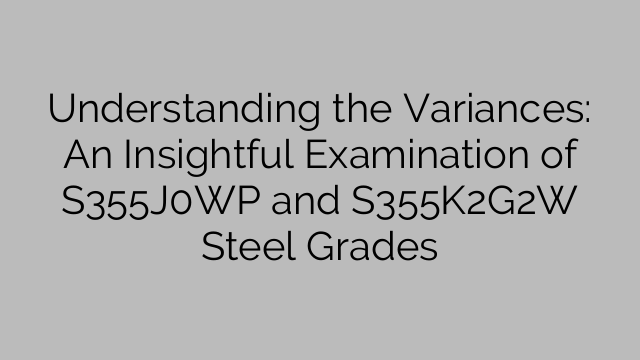Understanding the Variances: An Insightful Examination of S355J0WP and S355K2G2W Steel Grades
Steel is one of the most versatile and widely used materials across various industries. It comes in several grades, each with unique properties that make them suitable for specific applications. In this article, we will delve into the key differences between two popular steel grades: S355J0WP and S355K2G2W.
Both S355J0WP and S355K2G2W are weathering steel grades, also known as atmospheric corrosion-resistant steels. They are designed to have enhanced weathering resistance, allowing them to withstand harsh outdoor conditions without the need for surface coatings or paints. This makes them ideal for structures exposed to a wide range of weather conditions, such as buildings, bridges, and heavy equipment.
S355J0WP is a commonly used grade in the construction industry. It is a structural steel grade with a minimum yield strength of 355 MPa. The “J0” designation signifies that it has a minimum impact energy of 27 J at 0°C. This steel grade contains alloys such as copper, chromium, nickel, and phosphorus, which enhance its corrosion resistance properties.
On the other hand, S355K2G2W is a more specialized grade that offers even greater corrosion resistance. It is a structural steel grade with a minimum yield strength of 355 MPa, just like S355J0WP. However, the “K2G2W” designation indicates that it contains additional alloying elements, such as chromium, nickel, and phosphorus, which further enhance its weathering resistance properties.
One of the key differences between these two steel grades is the presence of extra alloying elements in S355K2G2W. These alloying elements contribute to the formation of a protective oxide layer on the surface of the steel when exposed to the atmosphere. This layer acts as a barrier, preventing further corrosion and degradation of the steel beneath.
In terms of mechanical properties, both S355J0WP and S355K2G2W have similar strength characteristics. They exhibit good weldability and formability, making them easy to work with during fabrication processes. This ensures that structures built with these steel grades retain their structural integrity over time.
However, it is worth noting that S355K2G2W offers slightly better corrosion resistance compared to S355J0WP due to its higher alloy content. This makes it suitable for applications in highly corrosive environments, such as coastal regions or areas with high levels of pollution.
When it comes to selecting the appropriate steel grade for a specific application, various factors need to be considered. These include the expected environmental conditions, the desired service life of the structure, and the budget constraints. Consulting with steel experts or structural engineers can help determine the most suitable grade for the intended use.
In conclusion, S355J0WP and S355K2G2W are two weathering steel grades that offer enhanced corrosion resistance compared to conventional structural steels. The main difference between the two lies in the additional alloying elements present in S355K2G2W, which provide superior weathering resistance. Understanding these variances allows engineers and designers to make informed decisions when selecting the ideal steel grade for their projects.

